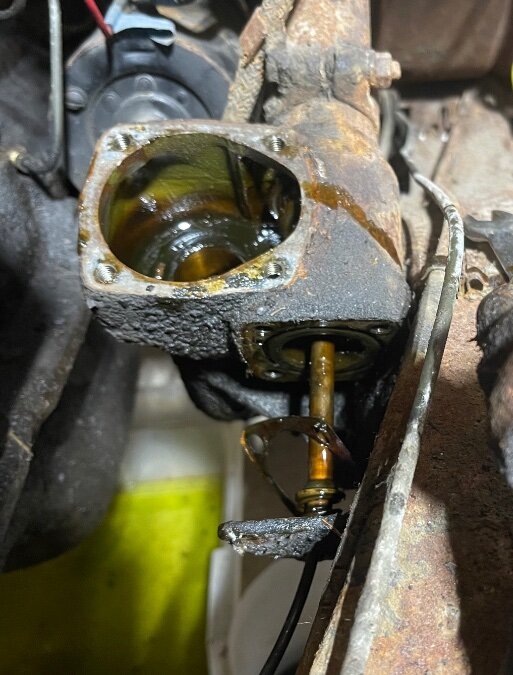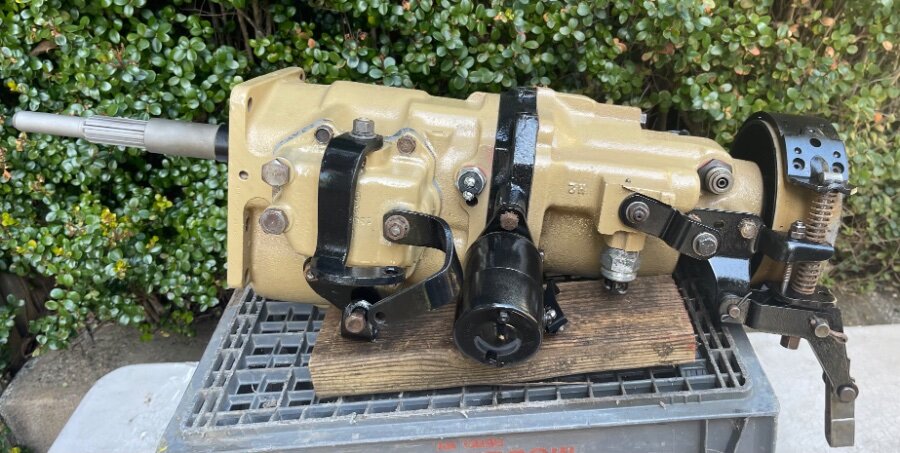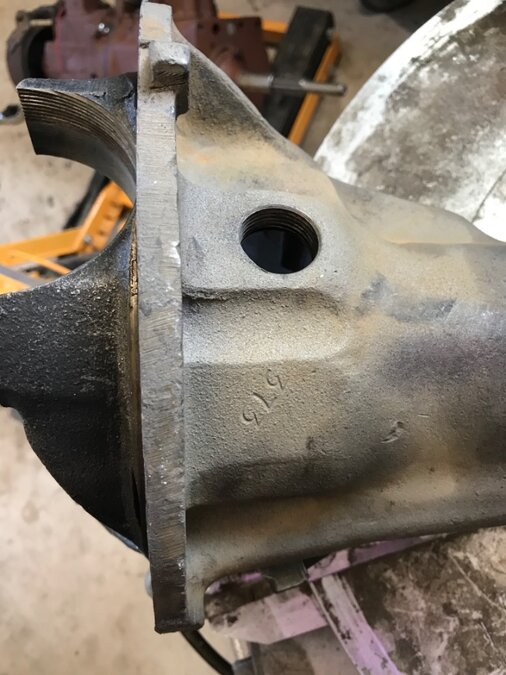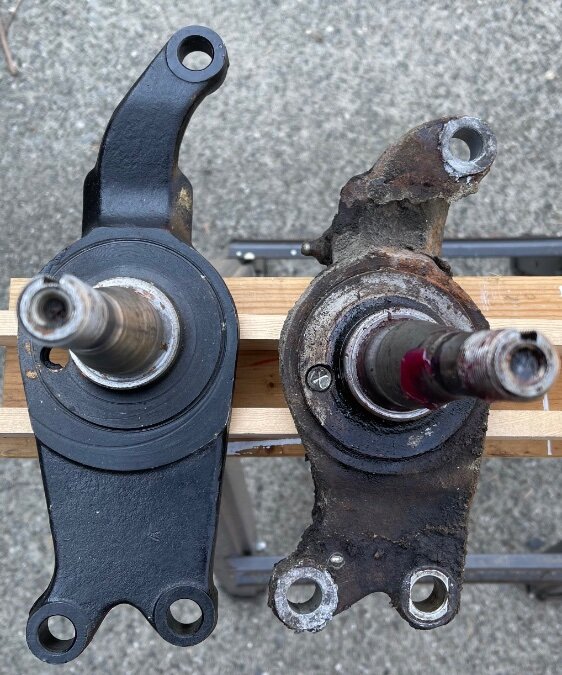-
Posts
819 -
Joined
-
Last visited
-
Days Won
16
Everything posted by Loren
-
Yes the grey one is my 49 P17. lots to love about them and lots to improve. They were the lightest cheapest car MoPar made. I’ve owned a 49 Special Deluxe Club Coupe and I can tell you it was a much nicer car. Things like an air cleaner that was silent, a horn ring, much better seat, nicer door panels, a passenger door lock, 2 horns, chrome around the windows, a front sway bar, a radio grill and more. The customer for a 3 passenger business coupe bought for the price. Where as the Special Deluxe cost more but you really got your money’s worth. I think. That said, you can always add the good stuff to one, then have the style and nice parts. In a nutshell the Deluxe models aren’t very and Special Deluxe ones really are.
-
Boy are you right! I have a 31 Model A 5 window coupe and it is tight quarters! Can you imagine a chopped top?! I couldn't drive such a car. Mine has a Miller-Schofield over head ( early Cragar ) on an A block, an F100 steering gear and it will have a 39 V8 trans with a torque tube mounted R10 Overdrive ( once I get rid of the T5 ) Just about as old school as can be ( vintage 1950s ) If you've ever driven a Model T or a Model A, you really appreciate a "Bigger on the inside, smaller on the outside" KT Keller Plymouth. Might as well be comfortable.
-
There was a time when fiberglass copies of old Fords were popular. It was a cheap & quick way to build a hot rod. Then that fell out of favor and guys bought complete restored cars and built hot rods out of them. They took a lot of heat for that so now you can buy complete 32 Ford bodies that are much better than any original for a reasonable price. I love the sales pitch, “All original! Even has a brand new Chevy crate motor!” “One of 400 made and 600 still existing!” We are stewards of cars that are older than we are ( in most cases ) they have survived wars and rumors of war ( I am thinking of the scrap drives of war ). To get to be 75 years old somebody had to preserve them. Actually many somebodies. So a great car can survive many owners. At 75 they start to get a little more respect than they did at 10 & 15. My goal is to be thought of as a good steward of my cars. I am not good at restoration but I can bring the mechanicals up to new standards and keep them there. You just have to do what you can….and have some fun!
-
What has always bugged me about engine swaps is it seems like there is no other engine in the world except a small block Chevy. It just seemed to me there was no imagination used when selecting them. However I am getting over that in my old age. Why not swap something like a Lexus V8? There's lots of them in wrecking yards and they are cheap because they just don't break and the market for them is slim. If I was to swap an engine it might be a Diesel. Plymouth experimented with Diesels ( Perkins ). I think I would use a Nissan SD6-33T engine from an IH Scout ( 1980 ). Since Chrysler was the importer of UD Nissan Trucks and engines at the time the valve cover even says "Chrysler Nissan" on it! If that's too run of the mill how about a real exotic? The V8 engine out of a Daimler SP 250? The ugliest sports car ever made had a small Hemi V8 which kind of goes with the MoPar theme. Maybe when AI becomes SOP one could try out the exotic combinations without spending much money. Bill Harrah had plenty of money to burn and when a Ferrari was wrecked ( I don't know if it was his or not ) He had the engine installed in a Jeep Wagoneer! If I was a friend of his with his kind of money, I would have bought a Wagoneer and had a 427 Ford installed, then challenge him to a race! Wagoneer to Wagoneer Mono a Mono. lol In a prefect world they would never let me get close to his kind of money because chaos would ensue! lol After all my years and all the cars I've worked on, I still think the body on frame MoPars were pretty damn good. Good enough to be the basis of somebody's dreams.
-
Diaphragm pressure plates usually require a different Throw Out Bearing. The T.O. Bearing needs to have a rounded contact surface so the spring fingers can roll over it. The fingers ( for want of knowing a better word ) on the standard pressure plate slide across the flat T.O. Bearing. So that is an item of concern if you're making the switch. Diaphragm Pressure plates have a low pedal pressure until they get worn, then it goes up. If you're familiar with this you can tell when a car needs a clutch just by stepping on the pedal. Plymouth made a lot of Taxi Cabs and one of the mods in the Taxi package was a 10 inch clutch. Thus they drilled all the flywheels with two patterns of bolt holes. However if you're planning to replace a worn 9 inch with a new 10 inch clutch you need to know the 10 inch uses bigger bolts. They are 3/8 x 16 nc which seems to be just like Big Block Chevy ( forgive my foul language ) I just ordered some from Summit Racing $9.99. ( back ordered at this time ) The 10 inch original type clutch that I got came from AB. I told them I had a 49 Plymouth and I wanted a 10 inch clutch, no problem. When you go to install your new clutch, you have to run a tap in the 3/8ths holes as they will have lots of crud in the threads. Start the tap on the clutch side as there is a straight section ( without threads ) which will align the tap and prevent cross threading. Rockauto has SKF T.O. Bearings which I hope are better than the noisy Chinese ones the AB sells. ( assume the Chinese bearings will last as long as the American made ones. I just can't put up with the noise )
-
0 to 60 in 5.2 seconds!? My Dad used to talk about Bonneville a lot when I was a wee child. He always said the land speed record could be had easily with electric power...you just needed a really long extension cord! That was well before Bullet Trains and lithium ion batteries, so it was funnier then than it is now ( hey I was a little kid and my Dad had a sense of humor ). I used to ask him who held the land speed record ( largely to see if I had met him. My Dad knew all the hot rodders at the time ) He'd say John Cobb and then he'd name the speed which was slightly over 400 mph as I recall. His buddy Tom Beatty had a Drop Tank who was going around 250 mph at the time on gasoline. He was very thrifty and didn't use alcohol because it was expensive, until they caught him. But he never used nitro for the same reason. lol I last saw his car in the Henry Ford Museum ( on loan ). Plymouths were a good low priced car that got repurposed unintentionally. Lee Petty figured out how he could use all sorts of stuff from the MoPar parts bin and actually make money racing....nobody does that! As Briggs Cunningham was fond of saying, "You know how to make a small fortune in racing? Start with a large one!" Just for reference a Flathead Plymouth could do the quarter mile in 22 seconds ( the decimal point numbers don't matter at 22 seconds lol ) or just about as fast as a Porsche 924! I love that statistic and bring it up as often as I can, having friends who were in love with that German company. So a 1950 Plymouth doing 0 to 60 in under 6 seconds would be a rather impressive ride! Too bad we couldn't get a flux capacitor and go back to the 1950s to race for pink slips!
-
I can’t tell you about the 40, I can tell you about the 49. If you want a better than stock ( my 49 Bus Coupe didn’t have one either ) “Sway Eliminator” I used a 50 Chrysler Windsor which is nearly 3/4 inch ( stock Plymouth is nearly 1/2 inch ) I believe Bob Riding put the same on his 40 Wagon. My point is with the Windsor/Royal bar you don’t have to do any engineering or modification. You just bolt it on. Take you about 15 minutes.
-
Hi John! Hot rodding seems to be very human. Everybody has their own take on it. Mostly we try to recreate our youth. When I got into Plymouths (49-54) they were called “Transportation Cars” and were available as needed for a standard price of $150. Out of high school I got a new car and over time it became my weekend race car, so I needed something more reliable. Thus I got a 49 Special Deluxe Club Coupe for $150. I could afford it and as long as I didn’t abuse it, I knew it would serve me forever. Now days old Plymouths are not $150 and they have decades more wear on them. So sometimes they need to have lots of deferred work done on them. Back in the 60s & 70s you never did any work on one. You got another one. It’s the American way that if you have to work on it, you want to make it better. I am caught up in that mode right now. I started off with a noisy throwout bearing, which became an Overdrive transmission with a new T.O. bearing that’s noisy, which became an Overdrive transmission with a 1940 gear set and an American made NOS throw bearing. You get the idea. It’s a fun thing that brings me joy. I am realistic, at my age I am not “restoring” this car. That’s too big a project. I am just having fun.
-
I replaced the seal on my 49's steering box as it was leaking badly. The seal is at the bottom of the box and that means if it's bad anything you put in there will leak. NAPA still has the listing for the seal. Here's how I did it. 1) take the pitman arm off the bottom of the sector. There's no need to remove the tie rods, but the car needs to be on reliable jack stands. 2) remove the lock cap from the top of the sector adjustment screw. ( do not mess with the adjustment! ) remove the top plate's bolts. Now mark the position of the slot in the sector adjustment screw on the top plate. If you push up on the sector the plate comes with it. The sector adjustment screw has a plate that slide into a slot in the top of the sector. Now this is tricky, you need to screw the adjustment in one turn in order to clear the housing to remove the top plate, when you push the sector up. ( the dimple in the top plate prevents it from coming off, so you have to turn the adjustment one turn ) 3) with the top plate off you can slide the sector completely out. This is where you want to inspect his for damage and extreme wear. If it looks reasonable replace the seal. 4) here's the key to the whole job. Grab ahold of the steering wheel and see if you can feel any play. Sometimes you can't but if the steering wheel turns super easy the bearings may have some wear. To get the play out of the tapered roller bearings on the worm gear/steering shaft, there are gasket/shims under the end plate. They come in various thicknesses and you will want to remove at least one. On my 49 I couldn't remove the end plate as it hits the frame but I could slide the end plate down a little to select the gasket I needed to remove. ( the tube that runs up the middle of the plate is for the horn wire and it doubles as a breather ) 5) put the bolts back in the end plate and check how the steering wheel feels. If it's tight you took up too much clearance and you'll need to add a thin gasket. If it's still loose try another thick gasket. I have found there's more play to be removed from the steering in this bearing than there is in the sector adjustment. In fact I try not to disturb the factory adjustment. They knew what they were doing. 6) Set the steering wheel at center and drop the sector in, slide the top plate into the sector and once in place turn the adjustment back one full turn. Now you can put the bolts in the top plate and add the oil. Put the pitman arm back on and check the steering. If you can't help yourself screw the adjustment in ONE notch and lock it in place with the cap. 7) road test. If all is well you're golden! In my humble opinion it's easier to try to fit the steering box than it is to replace it. The problem is usually in the preload of the tapered roller bearings. However there is always the possibility that it's too far gone.
-
Please don’t think I still get upset about hot rods. I’ve out grown that. The hot rod guys love really nice paint and chrome. Their cars look fantastic! But the fact is, they were never built that nice even by accident when they brand new. I’ve had the pleasure of closely inspecting genuine “original” Model T Fords. Let me tell you they were just awful! However original Model Ts are extremely rare, they all have been repainted with modern paint and if the owner repaints the car they usually make the body parts fit right. Henry never made them that nice and if he ever saw one that was perfect, he would be mystified how that happened. lol In my miss spent youth I was a dealer mechanic. My Plymouths follow the formula of what a dealer mechanic would drive back in the day. If I can find an improvement from another MoPar vehicle that a dealer mechanic would know about, my car will have it. I have a Model A that the previous owner installed a T5 in. I really don’t like it. I am changing it to a 39 V8 gearbox with a torque tube mounted R10 Overdrive. As far as the wiring and switches and solenoids go….well a dealer mechanic would have an Overdrive that worked as designed. I appreciate the charm of the 49 to 52 Plymouths. I don’t want to get too far away from that charm. I think the Overdrive does nothing to diminish that charm. That’s my formula and while I like it, no one else has to like it. In fact I like the idea that most folks would think my car is dead stock. It’s all about fun and enjoyment.
-
When I was young and dumb ( friends tell me I may not be young anymore but not much else has changed ) I used to feel bad when someone stuffed a V8 in an old car. Even though I lived for 30+ years in Northern Nevada, I never once bothered with Hot August Nights. Every nice old car had a Chevy V8 which was nothing I cared to see. Well I am changing my tune. Took long enough I suppose. I now love hot rods & resto-mods! You see the folks that build them usually have some great stuff to sell so they can pay for their new V8! And you can get some great deals. In the last couple of months I scored a 50 Chrysler Windsor chassis which yielded 12 inch brakes, a 3/4 inch front sway bar and a set of wheels ( wider by about an inch and a half ). I haven’t done the measurements yet but the lower front A-arms have the spring plates on the bottom, so you could lower the front if you used stock springs. This came from a guy who is putting a Dakota frame under his car with a V8. Yesterday I scored a very nice 230 engine with an Edgy head, Thickstun manifold, Stromberg carbs, rebuilt damper, T5 adaptor ( which I will never use as I prefer an Overdrive ) Reds headers and boxes of parts. This came from a guy who is putting a Chevy V8 in his pre-war Plymouth. I love the charm of my two flathead Plymouths, I always have. Putting a V8 in one just doesn’t fit with how I enjoy them. However, I no longer look down on what other folks do with their’s. Now I get excited by their engineering and craftsmanship. I am no engineer but I appreciate those who are. Are we in any danger of “running out of stock unmolested” cars? Probably not in my lifetime.
-

Just bought a Pertronix kit for the car
Loren replied to 1949plymouthdeluxe's topic in P15-D24 Forum
6 volt positive ground makes finding the right ignition a little troublesome. If you’re old enough you remember the point triggered CD ignition such as the Delta Mark Ten. You could buy them as a kit or fully assembled, so there are lots of guys out there who know how to fix them. A 6 volt Delta Mark Ten is rare and they are positive or negative ground ( but they can be changed ). In Canada the son of the inventor of the CD ignition has a little cottage business making 6 and 12 volt point triggered ignitions. Fred Winterburn, a very nice fellow. While none of the 6 volt Deltas had the switch to convert back to Kettering ignition ( like the 12 volt Mark Ten B ), the Winterburn does. In a CDI the points carry no load. They only act to provide a signal to the ignition so they last a very long time. Also because of this the point gap isn’t as critical as in Kettering type. Yes rubbing blocks wear but they wear less if lubed once in a while. So there’s a lot to like about a point triggered CDI. If you worry about EMP issues there is no substitute. lol -
Try AMC/Nash/Rambler Overdrive Kick Down Switch
-
Here’s a new idea Generally Mopar carburetors have a bracket and a pad on the throttle for the kick down. Rarely can you find one of those. When you do you can use the small switch that was also used on Studebakers. I found an almost identical switch that was used on bus doors and found a government surplus seller on eBay who had them for $6.50! They are very similar to the through the floor switches Ford products use. Many guys have put together attachments to the linkage. Some look good others look like crap. Here’s the new idea: Nash and ultimately Rambler used a switch I had never seen before until I went looking for parts for my Model A drive shaft Overdrive. It uses a cable operated switch that is small and simple and could mount under the coil/spark plug wire bracket. I bought two for $22 each nos on ebay. They are really slick you might have look at them. AMC / Nash / Rambler Overdrive kickdown switch eBay item #185671194447 p/n 3136724 $21.99 with free shipping I am ditching my crappy switch for one of these.
-
1940 is a little early for my experience but most I have seen are 9 1/4 inch. For a project I am working on I drug out a couple of flywheels I had surfaced a while back and discovered both were drilled for the 9 1/4 and the 10 inch clutch. I bought a flywheel from Vintage Power Wagons for a 251 ( government surplus ) and it was only drilled for the 10 inch. However it’s intended use was for a truck. A car could be for private use ( 9 1/4 ) or a taxi ( which we know had a 10 inch clutch as part of the taxi package ). 9 1/4 might be cheaper and 10 last longer, your choice. I would call A B and ask them as they have both. However get your throw out bearing NOS somewhere else.
-

Widest wheel and tire combo for a 49 special deluxe convertible
Loren replied to STX123's topic in P15-D24 Forum
How to get another gear? The easy answer is a mid 1952-55 ( 56 is 12 volt ) Plymouth Automatic Overdrive transmission. Turns a 55 mph car into a 70 mph. Uses the same shift linkage, same parking brake, the speedometer gear transfers from your old 3 speed and if your car is 118 inch wheel base it uses the same drive shaft. If you have a 111 inch wheel base you will have to make an extension rod for the parking brake and shorten your drive shaft. If you drive at 55 mph it makes the engine so quiet you’ll think your going 35! Check your rear end gear ratio by looking at the flat section under the fill plug, 3.73 works very nicely. -
I was going through some parts for a project engine I am working on and I noticed that the 4 crank bolt flywheel I had resurfaced was drilled for both the 9 1/4 inch clutch and the 10 inch clutch. I remembered that the taxi package included a 10 inch clutch. It seems the factory drilled them all. So since I have a new 10 inch clutch kit on the shelf, that’s what is going on the engine. Can’t imagine taxi drivers would put up with a stiffer clutch than a standard car is I am assuming the bigger clutch is for longer service life. Am I wrong?
-
Here’s a photo of the 12 inch beside a 10 inch for comparison. One of the highly desirable features of the KT Keller era cars is the continuity of design. You can mix and match parts in creative ways. Unfortunately sometimes its a pain like two different brake sizes in the same year and all you can find is the wrong one.
-

Are those cheap, new, aluminum radiators any good?
Loren replied to 1949plymouthdeluxe's topic in P15-D24 Forum
Decades ago I worked in a combination Olds dealer and when the parts department issued a water pump or a radiator they gave you two biscuits of “GM Sealant”. The biscuits were the diameter of the radiator filler and about an inch thick, so they would just drop in the radiator. It was “come back insurance”. Somehow those biscuits really worked and they didn’t coat the inside of the cooling system with crud that only a radiator shop could remove. Fast forward to modern times. I have a 2008 F 250 diesel and they are famous for their crappy plastic tank radiators. Like so many owners of these things I noticed an antifreeze puddle under the front of the truck one morning. A close inspection revealed a crack in the tank at the return hose about 1 3/4 long. I stopped at NAPA and got a package of those biscuits which are now available on cards everywhere, the patent has long ago run out. That was about 10 years ago and when the coolant went down a little about 5 years ago, I put two more in. I carry a couple in the truck but no coolant ( too bulky ). I like the original “Bee Hive” radiators and if mine springs a leak I’d find another and get it fixed. But I would not recore one. If it was a weeping leak I would use the biscuits first. It’s just my personal preference. -
They are different right to left. What size brakes do you have? Each size has a different spindle, that is 10 inch, 11 inch or 12 inch. I have a set of Plymouth 10 inch spindles I would donate for the shipping cost. For my cars I am changing over to Chrysler Windsor 12 inch brakes, so I have the “take offs” gathering dust.
-
I have one of Langdon’s HEI distributors too. I changed my mind about using it, so there it sits. One neat thing about them is you can use a multi-spark unit with them. Interestingly the ones I looked at are only in multi-spark mode until 3,600 rpm, which on a flathead is pretty much all the time. I am not certain if that would be beneficial but it is fascinating. I am staying with 6 volt and a point triggered CDI. I have two Delta Mark Tens and two much more modern Winterburn CDIs.
-
I just thought of something. ( I do think every once in a while lol ) On the old Saabs I still work on, they have a "T" shaft end which fits into a slot in the "inner driver" as we call it. After years of service they get a wear "divit" in the inner driver which makes itself known as a kind of "Clutch Chatter" as the front of the car raises upon taking off from a stop. The fix is real simple, you pop the inner drivers out and exchange them right to left. ( or left to right if you will lol) So my question is, if you take the drive shaft out will you find a wear spot in the trunnions? If so can you swap the drive shaft end for end or should the trunnions be replaced? It's only a guess so please don't hate me. lol
-

High Quality H4 Headlights for 12v Cars (Cheap!!)
Loren replied to Sam Buchanan's topic in P15-D24 Forum
Thanks Sam I looked too. One thing I am going to do is use the harness & relays for the Scout. They have the creepy GM headlight switch that is so common and burns up the connector plug when you use halogen lights. One of the IH parts suppliers has a “bright lights kit” that puts relays in the system and takes the load off the switch. For the price of their kit you could buy between 5 & 10 Toyota kits! My Plymouths are 6 volt and I plan on keeping them that way. 12 volt wiring is not approved for my 6 volt cars so I am going to roll my own for them. I have German made 6 volt “Bosch” type relays ( they aren’t Bosch however ) that should be perfect and ceramic headlamp plugs. -

High Quality H4 Headlights for 12v Cars (Cheap!!)
Loren replied to Sam Buchanan's topic in P15-D24 Forum
Sam, In the packaging there are instructions which seem to be printed for round, rectangular and small 4 lamp systems. I could really use a set of rectangular lamps for my 1980 Scout ll. However there are no part numbers for the other lamps. Do you think they can be bought on the same deal? -
I agree too much grease and you’ll have grease invading the brakes instead of oil. However if you lube up the bearing it will help. As I recall there’s a plug and a grease fitting. If you grease up the bearing as you put it together you don’t need anymore. If it’s altogether you might pull the plug and put one good shot of grease in the fitting. Pulling the plug allows air out so the grease doesn’t go out the seals. Another tip: when you remove the backing plate, tap out the bolts holding it to the housing. The 5 bolts tend to hold the plate making it difficult to remove without scrapping up the threads.









